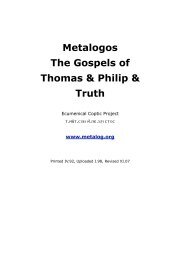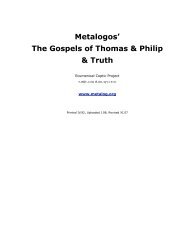Andrew Louth - Syriac Christian Church
Andrew Louth - Syriac Christian Church
Andrew Louth - Syriac Christian Church
You also want an ePaper? Increase the reach of your titles
YUMPU automatically turns print PDFs into web optimized ePapers that Google loves.
NOTES 205<br />
24 Providence and judgment are associated as a pair in Origenist theory.<br />
See chapter 5 of the Introduction.<br />
25 3 Kgd 19:9 ff.<br />
26 Probably an echo of both the chariot in which Elijah ascends into heaven<br />
in 4 Kgd 2:11, and of the chariot of the soul in Plato’s Phaedrus (246A–C).<br />
27 Cf. 4 Kgd 2:1ff.<br />
28 Probably commenting on 4 Kgd 1:9–12, but alluding also to 4 Kgd 6:15–<br />
17.<br />
29 Cf. 1 Kgd 1:9–20.<br />
30 Cf. Lev. 14:33–42.<br />
31 Cf. 3 Kgd 17:8–24.<br />
32 Cf. Matt. 17:1–8, Mark 9:2–8, Luke 9:28–36.<br />
33 Cf. Isa. 53:2.<br />
34 Cf. Psa. 44:3.<br />
35 Cf. John 1:1.<br />
36 Apophasis: Maximus introduces here the technical terms of apophatic<br />
and cataphatic theology.<br />
37 Cf. John 1:14.<br />
38 This section develops the theme just introduced in the dual<br />
interpretation of the radiant garments of the Transfigured Christ as<br />
both Scriptures and creation.<br />
39 The Evagrian triad of ascetic struggle (praktikê), natural contemplation<br />
(physikê), and theology was related by Origen to a very similar<br />
classification of the categories of philosophy in the prologue to his<br />
Commentary on the Song of Songs: see <strong>Louth</strong> (1981), 57–8.<br />
40 Cf. Denys the Areopagite, Ep. 9.1 (1105D).<br />
41 Literally: in a Greek way. It is in contrast with the later ‘in a Jewish<br />
way’: cf. St Paul’s contrast between Greeks/Gentiles and Jews,<br />
especially in Rom. 1–3.<br />
42 Cf. Phil. 3.19.<br />
43 A metaphor for the Incarnation used by Gregory Nazianzen in Sermon<br />
38.2 (PG 36:313B). Maximus devotes a Difficulty to Gregory’s use of the<br />
term (suspected of Origenism?): Amb. 33:1285C–1288A, where the<br />
Word’s expressing itself in letters and words is one of the<br />
interpretations offered of the metaphor.<br />
44 Cf. Gen. 39:11–12.<br />
45 This is an important section in which Maximus reworks a fundamental<br />
Evagrian theme. For Evagrius, the five modes of contemplation are: 1.<br />
contemplation of the adorable and holy Trinity, 2. and 3. contemplation<br />
of incorporeal and incorporeal beings, 4. and 5. contemplation of<br />
judgment and providence (Centuries on Spiritual Knowledge I.27, in<br />
Guillaumont [1958]). Maximus’ understanding is quite different. See<br />
Thunberg (1965), 69–75 and Gersh (1978), 226–7.<br />
46 I do not know where Maximus gets these five secret meanings (or<br />
hidden logoi) from. They recall Plato’s ‘five greatest kinds’ (being, rest,<br />
motion, sameness and difference: see Sophist 254D–255C), but are<br />
evidently not the same.<br />
47 One of the ‘Chalcedonian’ adverbs.




